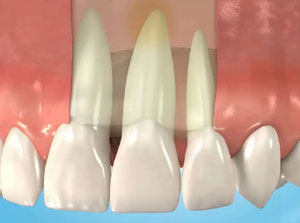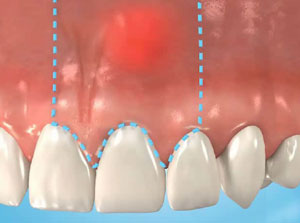Root tip removal
A root tip removal (also called root tip resection) is applied to an inflamed tooth root. The cause, for example, can be a very far-reaching caries disease. The root tip and the inflamed tissue surrounding the root tip are removed. This prevents the spread of infection to the bone and the development of abscesses. The goal is to preserve the tooth. A root tip removal may also be necessary in case of ruptures of the root, suspected tumors or cavities (cysts).
Root tip removal process
During root tip removal, the dentist cuts the gums and periosteum above the relevant tooth root. The gums are pushed away from the bone until it is freely accessible. In order to reach the root tip, the bone is removed with a special bone cutter. The dentist then shortens the inflamed root tip by a few millimeters with an elongated milling machine. Fine branched extensions of the root canal are removed as far as possible.
Next, the root canal is treated. Access here is usually from the tooth crown, which is drilled accordingly. The root canal is expanded, disinfected, dried and filled as in normal root canal treatment.
After removal of the inflamed tissue and careful cleaning of the bone cavity, the soft tissue is folded back and sutured. Finally, the tooth crown is provisionally closed. The final filling of the tooth occurs only after the wound has healed.
Frequently asked questions about root tip removal:
Which examinations are necessary to decide whether a root tip removal is necessary?
By means of an X-ray of the affected tooth, it is clarified whether the inflammation of the tooth root has spread to the jaw bones and what extent the inflammation has reached so far. The accessibility of the root tip is also checked with the help of the X-ray.
How long does the procedure take on average?
The duration of the procedure depends on the respective circumstances. As a rule, however, one can assume 15 to 30 minutes per root tip resection.
Is root tip removal a dangerous procedure?
Root tip removal is considered a low-risk procedure that can easily be performed on an outpatient basis. As with any operation, however, complications cannot be ruled out one hundred percent. However, your dentist will inform you comprehensively about rare complications such as local infections, wound healing disorders or nerve injuries before the procedure.
What are the dangers of root inflammation?
Due to the inflammation of the tooth root, the bone can regress. It can also lead to severe abscesses and cysts in the vicinity of the affected root which have a negative effect on the entire organism.
What are the risks of removing the root tip?
In addition to the normal risks associated with surgery, root tip removal can cause damage to a nerve. Likewise, to an irritation or infection of the maxillary sinus or to damage to the neighboring tooth roots. The exact risks are always explained individually in a personal conversation.
When should a root tip be removed?
Only the dentist can give you an exact recommendation, but there are some situations in which a root tip removal is recommended.
further information on root tip removal




